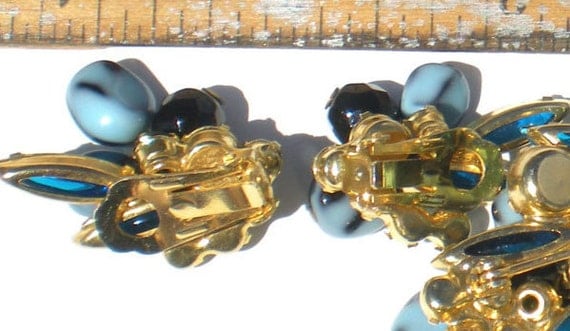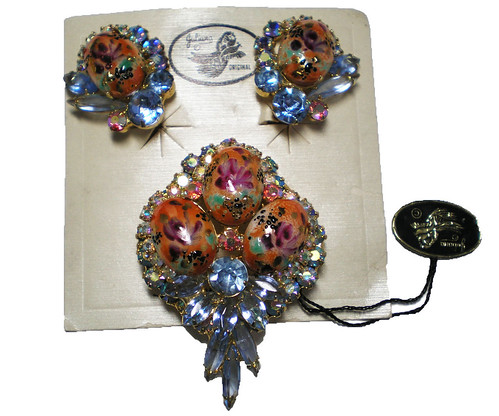Delizza & Elster - 1947 - 1990
Delizza and Elster manufactured jewelry of the highest quality. It is important to know that D&E manufactured jewelry for a multitude of different makers (such as Hollycraft, Weiss, and Judy Lee) so not all D&E jewelry is part of their "Juliana" line but all "Juliana" jewelry was designed and made by D&E. Always very solidly made this company unfortunately never signed their pieces but did paper label a line called Juliana in the late 60's.
The D&E stands for the last names of co-founders William DeLizza and Harold Elster that founded the company in 1947. The name "Juliana" comes from the name that was printed on the paper hangtags & display cards attached to their jewelry (which was never signed). Because their "Juliana" jewelry was never signed, it leads to a LOT of confusion about what is and what is not actually Juliana. Below are some tips on how to identify if your jewelry piece is actually Juliana or not. Never assign the name "Juliana" or call something "Juliana Style" unless you're sure it was one of their pieces. This merely leads to a frustration in buyers.
PLEASE NOTE The traits and styles of Juliana jewelry doesn't automatically classify it as a Juliana piece. Other manufacturers made similar jewelry that was also only marked with throw-away paper tags. So, for example, if you see figure-8 puddling in the soldering but it has a riveted pin assembly, it's very likely not Juliana.
Juliana - 1967 - 1968
Juliana is the 'house' brand label of Delizza and Elster. This company’s high quality rhinestone jewelry is unmarked and can only be identified through particular manufacturing techniques. Keep in mind that the colorful highly sought after pieces of Juliana jewelry aren't the only things they produced. Lots of clear crystal rhinestone pins/brooches on rhodium settings were hugely popular in the late 40s and early 50s.
Identification
Brooches
- Figure 8 Puddling
You can identify this characteristic by inspecting the back of your brooch. Notice where the chaton rhinestones are set, do the 'cups' the rhinestones are in form a figure 8 pattern?
- Built-in pin assembly (known as a joint and catch)
You can identify this characteristic by inspecting the back of your brooch. The pin assembly is soldered onto the brooch itself rather than being a separate entity.
This was the standard for D&E but on rare occasions a bar-pin was used for the sake of practicality.
Bracelets
- Five-Link Construction - The back of the link-style bracelet with have a link construction that rests underneath the base of the piece. There were three types of connector findings used to hold the links together: an arrow design, a tiny beaded striped design, an a lined striped design.
- Many D&E Bracelets have safety chains except the oldest styles.
- The end clasp is typically a fold-over style with an arrow design etched into it. Sometimes a single rhinestone is mounted on the center of the adjoining clasp. A brushed metal closure was sometimes used but is rather rare.
- Metal finishes varied from silver, gold, japanned, gun metal, rhodium plated and patinas.


Clamper Bracelets
- The only wire type used for mounting these bracelets are ones with square edges.

Necklaces
- Five-Link Construction

Earrings
In the multi-dimensional layered earrings, hard-drilled rivets were used as a support structure. The back of earrings typically have a scallop edge clip-back with three holes but sometimes only one or two punches were used.

Advertisements

1953 Jewelers' Buyers Guide PG 310








